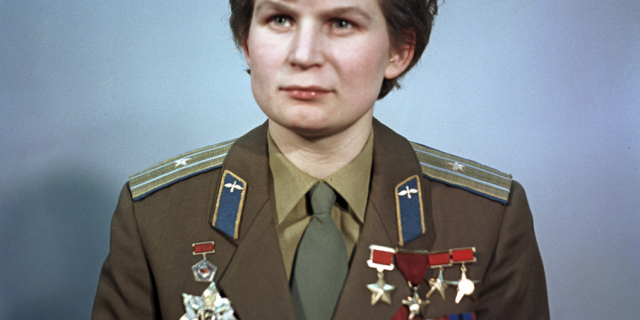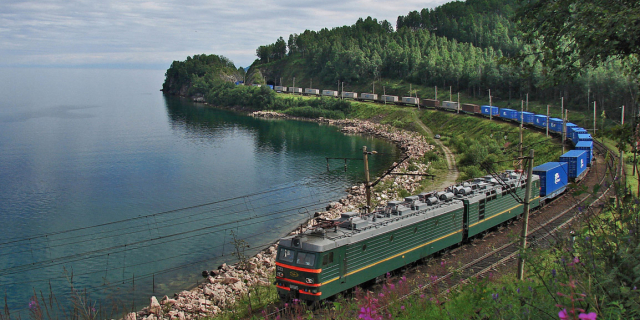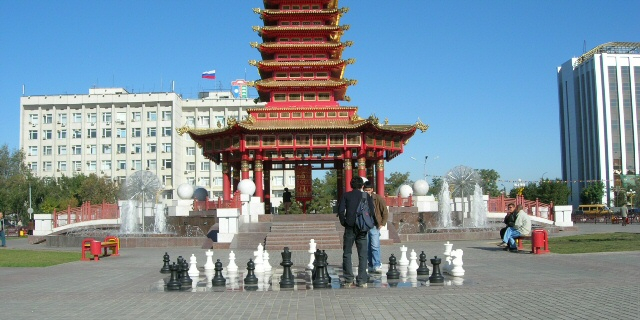Россия
RussiaContext of Russia
Russia (Russian: Россия, romanized: Rossiya, [rɐˈsʲijə]), or the Russian Federation, is a transcontinental country spanning Eastern Europe and Northern Asia. It is the largest country in the world, encompassing one-eighth of Earth's inhabitable landmass. Russia extends across eleven time zones and shares land boundaries with fourteen countries. It is the world's ninth-most populous country and Europe's most populous country. The country's capital and largest city is Moscow. Saint Petersburg is Russia's cultural centre and second-largest city. Other major urban areas include Novosibirsk, Yekaterinburg, Nizhny Novgorod, and Kazan.
The East Slavs emerged as a recognisable group in Europe between the 3rd and 8th centuries CE. The first East Slavic state, Kievan Rus', arose in the 9th century, and in 988, it adopted Orthodox Chri...Read more
Russia (Russian: Россия, romanized: Rossiya, [rɐˈsʲijə]), or the Russian Federation, is a transcontinental country spanning Eastern Europe and Northern Asia. It is the largest country in the world, encompassing one-eighth of Earth's inhabitable landmass. Russia extends across eleven time zones and shares land boundaries with fourteen countries. It is the world's ninth-most populous country and Europe's most populous country. The country's capital and largest city is Moscow. Saint Petersburg is Russia's cultural centre and second-largest city. Other major urban areas include Novosibirsk, Yekaterinburg, Nizhny Novgorod, and Kazan.
The East Slavs emerged as a recognisable group in Europe between the 3rd and 8th centuries CE. The first East Slavic state, Kievan Rus', arose in the 9th century, and in 988, it adopted Orthodox Christianity from the Byzantine Empire. Rus' ultimately disintegrated, with the Grand Duchy of Moscow growing to become the Tsardom of Russia. By the early 18th century, Russia had vastly expanded through conquest, annexation, and the efforts of Russian explorers, developing into the Russian Empire, which remains the third-largest empire in history. However, with the Russian Revolution in 1917, Russia's monarchic rule was abolished and eventually replaced by the Russian SFSR—the world's first constitutionally socialist state. Following the Russian Civil War, the Russian SFSR established the Soviet Union with three other Soviet republics, within which it was the largest and principal constituent. At the expense of millions of lives, the Soviet Union underwent rapid industrialisation in the 1930s, and later played a decisive role for the Allies of World War II by leading large-scale efforts on the Eastern Front. With the onset of the Cold War, it competed with the United States for global ideological influence; the Soviet era of the 20th century saw some of the most significant Russian technological achievements, including the first human-made satellite and the first human expedition into outer space.
In 1991, the Russian SFSR emerged from the dissolution of the Soviet Union as the independent Russian Federation. A new constitution was adopted, which established a federal semi-presidential system. Since the turn of the century, Russia's political system has been dominated by Vladimir Putin, under whom the country has experienced democratic backsliding and a shift towards authoritarianism. Russia has been involved militarily in a number of post-Soviet conflicts, which has included the internationally unrecognised annexations of Crimea in 2014 from neighbouring Ukraine, followed by the further annexation of four other regions in 2022 during an ongoing invasion. International rankings of Russia place it low in measurements of human rights and freedom of the press; the country also has high levels of perceived corruption.
The Russian economy ranks 65th by nominal GDP per capita globally and ranks among the largest in the world, relying chiefly upon its abundant natural resources. Its mineral and energy sources are the world's largest, and its figures for oil production and natural gas production rank high globally. Russia possesses the largest stockpile of nuclear weapons, and has the fifth-highest military expenditure. The country is a permanent member of the United Nations Security Council; a member state of the G20, the SCO, BRICS, the APEC, the OSCE, and the WTO; and is the leading member state of the CIS, the CSTO, and the EAEU. Russia is home to 30 UNESCO World Heritage Sites.
More about Russia
- Currency Russian ruble
- Native name Россия
- Calling code +7
- Internet domain .ru
- Speed limit 90
- Mains voltage 220V/50Hz
- Democracy index 3.31
- Population 137550949
- Area 17075400
- Driving side right
- Early history
The first human settlement on Russia dates back to the Oldowan period in the early Lower Paleolithic. About 2 million years ago, representatives of Homo erectus migrated to the Taman Peninsula in southern Russia.[1] Flint tools, some 1.5 million years old, have been discovered in the North Caucasus.[2] Radiocarbon dated specimens from Denisova Cave in the Altai Mountains estimate the oldest Denisovan specimen lived 195–122,700 years ago.[3] Fossils of Denny, an archaic human hybrid that was half Neanderthal and half Denisovan, and lived some 90,000 years ago, was also found within the latter cave.[4] Russia was home to some of the last surviving Neanderthals, from about 45,000 years ago, found in Mezmaiskaya cave.[5]
...Read moreEarly historyRead lessThe first human settlement on Russia dates back to the Oldowan period in the early Lower Paleolithic. About 2 million years ago, representatives of Homo erectus migrated to the Taman Peninsula in southern Russia.[1] Flint tools, some 1.5 million years old, have been discovered in the North Caucasus.[2] Radiocarbon dated specimens from Denisova Cave in the Altai Mountains estimate the oldest Denisovan specimen lived 195–122,700 years ago.[3] Fossils of Denny, an archaic human hybrid that was half Neanderthal and half Denisovan, and lived some 90,000 years ago, was also found within the latter cave.[4] Russia was home to some of the last surviving Neanderthals, from about 45,000 years ago, found in Mezmaiskaya cave.[5]
The first trace of an early modern human in Russia dates back to 45,000 years, in Western Siberia.[6] The discovery of high concentration cultural remains of anatomically modern humans, from at least 40,000 years ago, was found at Kostyonki–Borshchyovo,[7] and at Sungir, dating back to 34,600 years ago—both in western Russia.[8] Humans reached Arctic Russia at least 40,000 years ago, in Mamontovaya Kurya.[9] Ancient North Eurasian populations from Siberia genetically similar to Mal'ta–Buret' culture and Afontova Gora were an important genetic contributor to Ancient Native Americans and Eastern Hunter-Gatherers.[10]
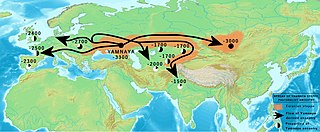 Bronze Age spread of Yamnaya Steppe pastoralist ancestry between 3300 and 1500 BC,[11] including the Afanasievo culture of southern Siberia.
Bronze Age spread of Yamnaya Steppe pastoralist ancestry between 3300 and 1500 BC,[11] including the Afanasievo culture of southern Siberia.The Kurgan hypothesis places the Volga-Dnieper region of southern Russia and Ukraine as the urheimat of the Proto-Indo-Europeans.[12] Early Indo-European migrations from the Pontic–Caspian steppe of Ukraine and Russia spread Yamnaya ancestry and Indo-European languages across large parts of Eurasia.[13][14] Nomadic pastoralism developed in the Pontic–Caspian steppe beginning in the Chalcolithic.[15] Remnants of these steppe civilizations were discovered in places such as Ipatovo,[15] Sintashta,[16] Arkaim,[17] and Pazyryk,[18] which bear the earliest known traces of horses in warfare.[16] The genetic makeup of speakers of the Uralic language family in northern Europe was shaped by migration from Siberia that began at least 3,500 years ago.[19] In classical antiquity, the Pontic-Caspian Steppe was known as Scythia.[20] In late 8th century BCE, Ancient Greek traders brought classical civilization to the trade emporiums in Tanais and Phanagoria.[21]
In the 3rd to 4th centuries CE, the Gothic kingdom of Oium existed in southern Russia, which was later overrun by Huns.[22][failed verification] Between the 3rd and 6th centuries CE, the Bosporan Kingdom, which was a Hellenistic polity that succeeded the Greek colonies,[23] was also overwhelmed by nomadic invasions led by warlike tribes such as the Huns and Eurasian Avars.[24] The Khazars, who were of Turkic origin, ruled the steppes between the Caucasus in the south, to the east past the Volga river basin, and west as far as Kyiv on the Dnieper river until the 10th century.[25] After them came the Pechenegs who created a large confederacy, which was subsequently taken over by the Cumans and the Kipchaks.[26]
The ancestors of Russians are among the Slavic tribes that separated from the Proto-Indo-Europeans, who appeared in the northeastern part of Europe c. 1500 years ago.[27] The East Slavs gradually settled western Russia in two waves: one moving from Kiev towards present-day Suzdal and Murom and another from Polotsk towards Novgorod and Rostov. From the 7th century onwards, the East Slavs constituted the bulk of the population in western Russia,[28] and slowly but peacefully assimilated the native Finnic peoples.[22]
Kievan Rus'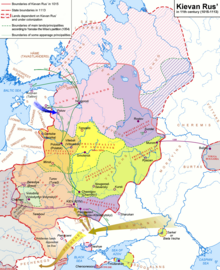 Kievan Rus' after the Council of Liubech in 1097
Kievan Rus' after the Council of Liubech in 1097The establishment of the first East Slavic states in the 9th century coincided with the arrival of Varangians, the Vikings who ventured along the waterways extending from the eastern Baltic to the Black and Caspian Seas.[29] According to the Primary Chronicle, a Varangian from the Rus' people, named Rurik, was elected ruler of Novgorod in 862. In 882, his successor Oleg ventured south and conquered Kiev, which had been previously paying tribute to the Khazars.[22] Rurik's son Igor and Igor's son Sviatoslav subsequently subdued all local East Slavic tribes to Kievan rule, destroyed the Khazar Khaganate,[30] and launched several military expeditions to Byzantium and Persia.[31][32]
In the 10th to 11th centuries, Kievan Rus' became one of the largest and most prosperous states in Europe. The reigns of Vladimir the Great (980–1015) and his son Yaroslav the Wise (1019–1054) constitute the Golden Age of Kiev, which saw the acceptance of Orthodox Christianity from Byzantium, and the creation of the first East Slavic written legal code, the Russkaya Pravda.[22] The age of feudalism and decentralisation had come, marked by constant in-fighting between members of the Rurik dynasty that ruled Kievan Rus' collectively. Kiev's dominance waned, to the benefit of Vladimir-Suzdal in the north-east, the Novgorod Republic in the north, and Galicia-Volhynia in the south-west.[22] By the 12th century, Kiev lost its pre-eminence and Kievan Rus' had fragmented into different principalities.[33] Prince Andrey Bogolyubsky sacked Kiev in 1169 and made Vladimir his base,[33] leading to political power being shifted to the north-east.[22]
Led by Prince Alexander Nevsky, Novgorodians repelled the invading Swedes in the Battle of the Neva in 1240,[34] as well as the Germanic crusaders in the Battle on the Ice in 1242.[35]
Kievan Rus' finally fell to the Mongol invasion of 1237–1240, which resulted in the sacking of Kiev and other cities, as well as the death of a major part of the population.[22] The invaders, later known as Tatars, formed the state of the Golden Horde, which ruled over Russia for the next two centuries.[36] Only the Novgorod Republic escaped foreign occupation after it surrendered and agreed to pay tribute to the Mongols.[22] Galicia-Volhynia would later be absorbed by Lithuania and Poland, while the Novgorod Republic continued to prosper in the north. In the northeast, the Byzantine-Slavic traditions of Kievan Rus' were adapted to form the Russian autocratic state.[22]
Grand Duchy of Moscow Sergius of Radonezh blessing Dmitry Donskoy in Trinity Sergius Lavra, before the Battle of Kulikovo, depicted in a painting by Ernst Lissner
Sergius of Radonezh blessing Dmitry Donskoy in Trinity Sergius Lavra, before the Battle of Kulikovo, depicted in a painting by Ernst LissnerThe destruction of Kievan Rus' saw the eventual rise of the Grand Duchy of Moscow, initially a part of Vladimir-Suzdal.[37]: 11–20 While still under the domain of the Mongol-Tatars and with their connivance, Moscow began to assert its influence in the region in the early 14th century,[38] gradually becoming the leading force in the "gathering of the Russian lands".[39] When the seat of the Metropolitan of the Russian Orthodox Church moved to Moscow in 1325, its influence increased.[40] Moscow's last rival, the Novgorod Republic, prospered as the chief fur trade centre and the easternmost port of the Hanseatic League.[41]
Led by Prince Dmitry Donskoy of Moscow, the united army of Russian principalities inflicted a milestone defeat on the Mongol-Tatars in the Battle of Kulikovo in 1380.[22] Moscow gradually absorbed its parent duchy and surrounding principalities, including formerly strong rivals such as Tver and Novgorod.[39]
Ivan III ("the Great") finally threw off the control of the Golden Horde and consolidated the whole of northern Rus' under Moscow's dominion, and was the first Russian ruler to take the title "Grand Duke of all Rus'". After the fall of Constantinople in 1453, Moscow claimed succession to the legacy of the Eastern Roman Empire. Ivan III married Sophia Palaiologina, the niece of the last Byzantine emperor Constantine XI, and made the Byzantine double-headed eagle his own, and eventually Russia's, coat-of-arms.[39] Vasili III completed the task of uniting all of Russia by annexing the last few independent Russian states in the early 16th century.[42]
Tsardom of Russia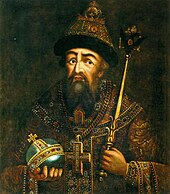 Ivan IV was the Grand Prince of Moscow from 1533 to 1547, then Tsar of Russia until his death in 1584.
Ivan IV was the Grand Prince of Moscow from 1533 to 1547, then Tsar of Russia until his death in 1584.In development of the Third Rome ideas, the grand duke Ivan IV ("the Terrible") was officially crowned the first tsar of Russia in 1547. The tsar promulgated a new code of laws (Sudebnik of 1550), established the first Russian feudal representative body (the Zemsky Sobor), revamped the military, curbed the influence of the clergy, and reorganised local government.[39] During his long reign, Ivan nearly doubled the already large Russian territory by annexing the three Tatar khanates: Kazan and Astrakhan along the Volga,[43] and the Khanate of Sibir in southwestern Siberia. Ultimately, by the end of the 16th century, Russia expanded east of the Ural Mountains.[44] However, the Tsardom was weakened by the long and unsuccessful Livonian War against the coalition of the Kingdom of Poland and the Grand Duchy of Lithuania (later the united Polish–Lithuanian Commonwealth), the Kingdom of Sweden, and Denmark–Norway for access to the Baltic coast and sea trade.[45] In 1572, an invading army of Crimean Tatars were thoroughly defeated in the crucial Battle of Molodi.[46]
The death of Ivan's sons marked the end of the ancient Rurik dynasty in 1598, and in combination with the disastrous famine of 1601–1603, led to a civil war, the rule of pretenders, and foreign intervention during the Time of Troubles in the early 17th century.[47] The Polish–Lithuanian Commonwealth, taking advantage, occupied parts of Russia, extending into the capital Moscow.[48] In 1612, the Poles were forced to retreat by the Russian volunteer corps, led by merchant Kuzma Minin and prince Dmitry Pozharsky.[49] The Romanov dynasty acceded to the throne in 1613 by the decision of the Zemsky Sobor, and the country started its gradual recovery from the crisis.[50]
Russia continued its territorial growth through the 17th century, which was the age of the Cossacks.[51] In 1654, the Ukrainian leader, Bohdan Khmelnytsky, offered to place Ukraine under the protection of the Russian tsar, Alexis; whose acceptance of this offer led to another Russo-Polish War. Ultimately, Ukraine was split along the Dnieper, leaving the eastern part, (Left-bank Ukraine and Kiev) under Russian rule.[52] In the east, the rapid Russian exploration and colonisation of vast Siberia continued, hunting for valuable furs and ivory. Russian explorers pushed eastward primarily along the Siberian River Routes, and by the mid-17th century, there were Russian settlements in eastern Siberia, on the Chukchi Peninsula, along the Amur River, and on the coast of the Pacific Ocean.[51] In 1648, Semyon Dezhnyov became the first European to navigate through the Bering Strait.[53]
Imperial Russia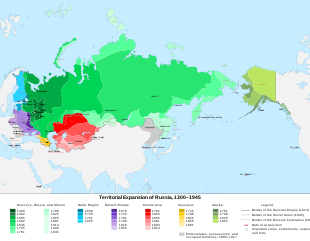 Expansion and territorial evolution of the Grand Duchy of Moscow, Tsardom of Russia and Russian Empire between the 14th and 20th centuries
Expansion and territorial evolution of the Grand Duchy of Moscow, Tsardom of Russia and Russian Empire between the 14th and 20th centuriesUnder Peter the Great, Russia was proclaimed an empire in 1721, and established itself as one of the European great powers. Ruling from 1682 to 1725, Peter defeated Sweden in the Great Northern War (1700–1721), securing Russia's access to the sea and sea trade. In 1703, on the Baltic Sea, Peter founded Saint Petersburg as Russia's new capital. Throughout his rule, sweeping reforms were made, which brought significant Western European cultural influences to Russia.[54] The reign of Peter I's daughter Elizabeth in 1741–1762 saw Russia's participation in the Seven Years' War (1756–1763). During the conflict, Russian troops overran East Prussia, reaching Berlin.[55] However, upon Elizabeth's death, all these conquests were returned to the Kingdom of Prussia by pro-Prussian Peter III of Russia.[56]
Catherine II ("the Great"), who ruled in 1762–1796, presided over the Russian Age of Enlightenment. She extended Russian political control over the Polish–Lithuanian Commonwealth and annexed most of its territories into Russia, making it the most populous country in Europe.[57] In the south, after the successful Russo-Turkish Wars against the Ottoman Empire, Catherine advanced Russia's boundary to the Black Sea, by dissolving the Crimean Khanate, and annexing Crimea.[58] As a result of victories over Qajar Iran through the Russo-Persian Wars, by the first half of the 19th century, Russia also conquered the Caucasus.[59] Catherine's successor, her son Paul, was unstable and focused predominantly on domestic issues.[60] Following his short reign, Catherine's strategy was continued with Alexander I's (1801–1825) wresting of Finland from the weakened Sweden in 1809,[61] and of Bessarabia from the Ottomans in 1812.[62] In North America, the Russians became the first Europeans to reach and colonise Alaska.[63] In 1803–1806, the first Russian circumnavigation was made.[64] In 1820, a Russian expedition discovered the continent of Antarctica.[65]
During the Napoleonic Wars, Russia joined alliances with various European powers, and fought against France. The French invasion of Russia at the height of Napoleon's power in 1812 reached Moscow, but eventually failed miserably as the obstinate resistance in combination with the bitterly cold Russian winter led to a disastrous defeat of invaders, in which the pan-European Grande Armée faced utter destruction. Led by Mikhail Kutuzov and Michael Andreas Barclay de Tolly, the Imperial Russian Army ousted Napoleon and drove throughout Europe in the War of the Sixth Coalition, ultimately entering Paris.[66] Alexander I controlled Russia's delegation at the Congress of Vienna, which defined the map of post-Napoleonic Europe.[67]
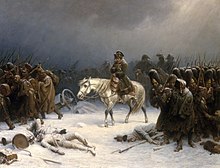 Napoleon's retreat from Moscow by Albrecht Adam (1851)
Napoleon's retreat from Moscow by Albrecht Adam (1851)The officers who pursued Napoleon into Western Europe brought ideas of liberalism back to Russia, and attempted to curtail the tsar's powers during the abortive Decembrist revolt of 1825.[68] At the end of the conservative reign of Nicholas I (1825–1855), a zenith period of Russia's power and influence in Europe, was disrupted by defeat in the Crimean War.[69] Nicholas's successor Alexander II (1855–1881) enacted significant changes throughout the country, including the emancipation reform of 1861.[70] These reforms spurred industrialisation, and modernised the Imperial Russian Army, which liberated much of the Balkans from Ottoman rule in the aftermath of the 1877–1878 Russo-Turkish War.[71] During most of the 19th and early 20th century, Russia and Britain colluded over Afghanistan and its neighboring territories in Central and South Asia; the rivalry between the two major European empires came to be known as the Great Game.[72]
The late 19th century saw the rise of various socialist movements in Russia. Alexander II was assassinated in 1881 by revolutionary terrorists.[73] The reign of his son Alexander III (1881–1894) was less liberal but more peaceful.[74] Under last Russian emperor, Nicholas II (1894–1917), the Revolution of 1905 was triggered by the failure of the humiliating Russo-Japanese War.[75] The uprising was put down, but the government was forced to concede major reforms (Russian Constitution of 1906), including granting freedoms of speech and assembly, the legalisation of political parties, and the creation of an elected legislative body, the State Duma.[76]
Revolution and civil war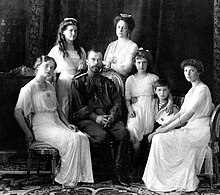 Emperor Nicholas II of Russia and the Romanovs were executed by the Bolsheviks in 1918.
Emperor Nicholas II of Russia and the Romanovs were executed by the Bolsheviks in 1918.In 1914, Russia entered World War I in response to Austria-Hungary's declaration of war on Russia's ally Serbia,[77] and fought across multiple fronts while isolated from its Triple Entente allies.[78] In 1916, the Brusilov Offensive of the Imperial Russian Army almost completely destroyed the Austro-Hungarian Army.[79] However, the already-existing public distrust of the regime was deepened by the rising costs of war, high casualties, and rumors of corruption and treason. All this formed the climate for the Russian Revolution of 1917, carried out in two major acts.[80] In early 1917, Nicholas II was forced to abdicate; he and his family were imprisoned and later executed in Yekaterinburg during the Russian Civil War.[81] The monarchy was replaced by a shaky coalition of political parties that declared itself the Provisional Government.[82] The Provisional Government proclaimed the Russian Republic in September. On 19 January [O.S. 6 January], 1918, the Russian Constituent Assembly declared Russia a democratic federal republic (thus ratifying the Provisional Government's decision). The next day the Constituent Assembly was dissolved by the All-Russian Central Executive Committee.[80]
An alternative socialist establishment co-existed, the Petrograd Soviet, wielding power through the democratically elected councils of workers and peasants, called soviets. The rule of the new authorities only aggravated the crisis in the country instead of resolving it, and eventually, the October Revolution, led by Bolshevik leader Vladimir Lenin, overthrew the Provisional Government and gave full governing power to the soviets, leading to the creation of the world's first socialist state.[80] The Russian Civil War broke out between the anti-communist White movement and the Bolsheviks with its Red Army.[83] In the aftermath of signing the Treaty of Brest-Litovsk that concluded hostilities with the Central Powers of World War I; Bolshevist Russia surrendered most of its western territories, which hosted 34% of its population, 54% of its industries, 32% of its agricultural land, and roughly 90% of its coal mines.[84]
 Vladimir Lenin and Leon Trotsky during a 1920 speech in Moscow
Vladimir Lenin and Leon Trotsky during a 1920 speech in MoscowThe Allied powers launched an unsuccessful military intervention in support of anti-communist forces.[85] In the meantime, both the Bolsheviks and White movement carried out campaigns of deportations and executions against each other, known respectively as the Red Terror and White Terror.[86] By the end of the violent civil war, Russia's economy and infrastructure were heavily damaged, and as many as 10 million perished during the war, mostly civilians.[87] Millions became White émigrés,[88] and the Russian famine of 1921–1922 claimed up to five million victims.[89]
Soviet Union Location of the Russian SFSR (red) within the Soviet Union in 1936
Location of the Russian SFSR (red) within the Soviet Union in 1936On 30 December 1922, Lenin and his aides formed the Soviet Union, by joining the Russian SFSR into a single state with the Byelorussian, Transcaucasian, and Ukrainian republics.[90] Eventually internal border changes and annexations during World War II created a union of 15 republics; the largest in size and population being the Russian SFSR, which dominated the union for its entire history politically, culturally, and economically.[91][failed verification] Following Lenin's death in 1924, a troika was designated to take charge. Eventually Joseph Stalin, the General Secretary of the Communist Party, managed to suppress all opposition factions and consolidate power in his hands to become the country's dictator by the 1930s.[92] Leon Trotsky, the main proponent of world revolution, was exiled from the Soviet Union in 1929,[93] and Stalin's idea of Socialism in One Country became the official line.[94] The continued internal struggle in the Bolshevik party culminated in the Great Purge.[95]
Under Stalin's leadership, the government launched a command economy, industrialisation of the largely rural country, and collectivisation of its agriculture. During this period of rapid economic and social change, millions of people were sent to penal labor camps, including many political convicts for their suspected or real opposition to Stalin's rule;[96] and millions were deported and exiled to remote areas of the Soviet Union.[97] The transitional disorganisation of the country's agriculture, combined with the harsh state policies and a drought,[98] led to the Soviet famine of 1932–1933; which killed up to 8.7 million, 3.3 million of them in the Russian SFSR.[99] The Soviet Union, ultimately, made the costly transformation from a largely agrarian economy to a major industrial powerhouse within a short span of time.[100]
World War II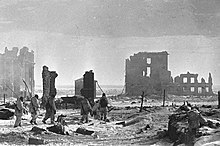 The Battle of Stalingrad, the largest and bloodiest battle in the history of warfare, ended in 1943 with a decisive Soviet victory against the German army.
The Battle of Stalingrad, the largest and bloodiest battle in the history of warfare, ended in 1943 with a decisive Soviet victory against the German army.The Soviet Union entered World War II on 17 September 1939 with its invasion of Poland,[101] in accordance with a secret protocol within the Molotov–Ribbentrop Pact with Nazi Germany.[102] The Soviet Union later invaded Finland,[103] and occupied and annexed the Baltic states,[104] as well as parts of Romania.[105]: 91–95 On 22 June 1941, Germany invaded the Soviet Union,[106] opening the Eastern Front, the largest theater of World War II.[107]: 7
Eventually, some 5 million Red Army troops were captured by the Nazis;[108]: 272 the latter deliberately starved to death or otherwise killed 3.3 million Soviet POWs, and a vast number of civilians, as the "Hunger Plan" sought to fulfill Generalplan Ost.[109]: 175–186 Although the Wehrmacht had considerable early success, their attack was halted in the Battle of Moscow.[110] Subsequently, the Germans were dealt major defeats first at the Battle of Stalingrad in the winter of 1942–1943,[111] and then in the Battle of Kursk in the summer of 1943.[112] Another German failure was the Siege of Leningrad, in which the city was fully blockaded on land between 1941 and 1944 by German and Finnish forces, and suffered starvation and more than a million deaths, but never surrendered.[113] Soviet forces steamrolled through Eastern and Central Europe in 1944–1945 and captured Berlin in May 1945.[114] In August 1945, the Red Army invaded Manchuria and ousted the Japanese from Northeast Asia, contributing to the Allied victory over Japan.[115]
The 1941–1945 period of World War II is known in Russia as the Great Patriotic War.[116] The Soviet Union, along with the United States, the United Kingdom and China were considered the Big Four of Allied powers in World War II, and later became the Four Policemen, which was the foundation of the United Nations Security Council.[117]: 27 During the war, Soviet civilian and military death were about 26–27 million,[118] accounting for about half of all World War II casualties.[119]: 295 The Soviet economy and infrastructure suffered massive devastation, which caused the Soviet famine of 1946–1947.[120] However, at the expense of a large sacrifice, the Soviet Union emerged as a global superpower.[121]
Cold War The "Big Three" at the Yalta Conference in February 1945, Winston Churchill, Franklin D. Roosevelt and Joseph Stalin
The "Big Three" at the Yalta Conference in February 1945, Winston Churchill, Franklin D. Roosevelt and Joseph StalinAfter World War II, parts of Eastern and Central Europe, including East Germany and eastern parts of Austria were occupied by Red Army according to the Potsdam Conference.[122] Dependent communist governments were installed in the Eastern Bloc satellite states.[123] After becoming the world's second nuclear power,[124] the Soviet Union established the Warsaw Pact alliance,[125] and entered into a struggle for global dominance, known as the Cold War, with the rivaling United States and NATO.[126] After Stalin's death in 1953 and a short period of collective rule, the new leader Nikita Khrushchev denounced Stalin and launched the policy of de-Stalinization, releasing many political prisoners from the Gulag labor camps.[127] The general easement of repressive policies became known later as the Khrushchev Thaw.[128] At the same time, Cold War tensions reached its peak when the two rivals clashed over the deployment of the United States Jupiter missiles in Turkey and Soviet missiles in Cuba.[129]
In 1957, the Soviet Union launched the world's first artificial satellite, Sputnik 1, thus starting the Space Age.[130] Russian cosmonaut Yuri Gagarin became the first human to orbit the Earth, aboard the Vostok 1 manned spacecraft on 12 April 1961.[131] Following the ousting of Khrushchev in 1964, another period of collective rule ensued, until Leonid Brezhnev became the leader. The era of the 1970s and the early 1980s was later designated as the Era of Stagnation. The 1965 Kosygin reform aimed for partial decentralisation of the Soviet economy.[132] In 1979, after a communist-led revolution in Afghanistan, Soviet forces invaded the country, ultimately starting the Soviet–Afghan War.[133] In May 1988, the Soviets started to withdraw from Afghanistan, due to international opposition, persistent anti-Soviet guerrilla warfare, and a lack of support by Soviet citizens.[134]
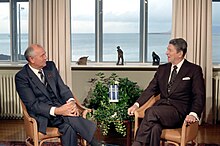 Mikhail Gorbachev in one-to-one discussions with Ronald Reagan in the Reykjavík Summit, 1986
Mikhail Gorbachev in one-to-one discussions with Ronald Reagan in the Reykjavík Summit, 1986From 1985 onwards, the last Soviet leader Mikhail Gorbachev, who sought to enact liberal reforms in the Soviet system, introduced the policies of glasnost (openness) and perestroika (restructuring) in an attempt to end the period of economic stagnation and to democratise the government.[135] This, however, led to the rise of strong nationalist and separatist movements across the country.[136] Prior to 1991, the Soviet economy was the world's second-largest, but during its final years, it went into a crisis.[137]
By 1991, economic and political turmoil began to boil over as the Baltic states chose to secede from the Soviet Union.[138] On 17 March, a referendum was held, in which the vast majority of participating citizens voted in favour of changing the Soviet Union into a renewed federation.[139] In June 1991, Boris Yeltsin became the first directly elected president in Russian history when he was elected president of the Russian SFSR.[140] In August 1991, a coup d'état attempt by members of Gorbachev's government, directed against Gorbachev and aimed at preserving the Soviet Union, instead led to the end of the Communist Party of the Soviet Union.[141] On 25 December 1991, following the dissolution of the Soviet Union, along with contemporary Russia, fourteen other post-Soviet states emerged.[142]
Post-Soviet Russia (1991–present)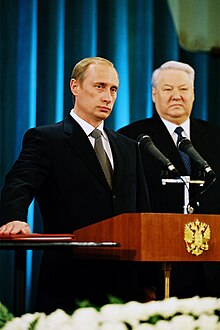 Vladimir Putin takes the oath of office as president on his first inauguration, with Boris Yeltsin looking over, 2000.
Vladimir Putin takes the oath of office as president on his first inauguration, with Boris Yeltsin looking over, 2000.The economic and political collapse of the Soviet Union led Russia into a deep and prolonged depression. During and after the disintegration of the Soviet Union, wide-ranging reforms including privatisation and market and trade liberalisation were undertaken, including radical changes along the lines of "shock therapy".[143] The privatisation largely shifted control of enterprises from state agencies to individuals with inside connections in the government, which led to the rise of the infamous Russian oligarchs.[144] Many of the newly rich moved billions in cash and assets outside of the country in an enormous capital flight.[145] The depression of the economy led to the collapse of social services—the birth rate plummeted while the death rate skyrocketed,[146][147] and millions plunged into poverty;[148] while extreme corruption,[149] as well as criminal gangs and organised crime rose significantly.[150]
In late 1993, tensions between Yeltsin and the Russian parliament culminated in a constitutional crisis which ended violently through military force. During the crisis, Yeltsin was backed by Western governments, and over 100 people were killed.[151] In December, a referendum was held and approved, which introduced a new constitution, giving the president enormous powers.[152] The 1990s were plagued by armed conflicts in the North Caucasus, both local ethnic skirmishes and separatist Islamist insurrections.[153] From the time Chechen separatists declared independence in the early 1990s, an intermittent guerrilla war was fought between the rebel groups and Russian forces.[154] Terrorist attacks against civilians were carried out by Chechen separatists, claiming the lives of thousands of Russian civilians.[a][155]
After the dissolution of the Soviet Union, Russia assumed responsibility for settling the latter's external debts.[156] In 1992, most consumer price controls were eliminated, causing extreme inflation and significantly devaluing the rouble.[157] High budget deficits coupled with increasing capital flight and inability to pay back debts, caused the 1998 Russian financial crisis, which resulted in a further GDP decline.[158]
On 31 December 1999, president Yeltsin unexpectedly resigned,[159] handing the post to the recently appointed prime minister and his chosen successor, Vladimir Putin.[160] Putin then won the 2000 presidential election,[161] and defeated the Chechen insurgency in the Second Chechen War.[162] Putin won a second presidential term in 2004.[163] High oil prices and a rise in foreign investment saw the Russian economy and living standards improve significantly.[164] Putin's rule increased stability, while transforming Russia into an authoritarian state.[165] In 2008, Putin took the post of prime minister, while Dmitry Medvedev was elected president for one term, to hold onto power despite legal term limits;[166] this period has been described as a "tandemocracy."[167]
 Russian-occupied territories of Ukraine as of 30 September 2022 at the time their annexation was declared
Russian-occupied territories of Ukraine as of 30 September 2022 at the time their annexation was declaredFollowing a diplomatic crisis with neighbouring Georgia, the Russo-Georgian War took place during 1–12 August 2008, resulting in Russia recognising two separatist states in the territories that it occupies in Georgia.[168] It was the first European war of the 21st century.[169]
In early 2014, following a revolution in Ukraine, Russia occupied and annexed Crimea from neighbouring Ukraine following a disputed referendum,[170] with Russian troops later participating in a war in eastern Ukraine between Russian-backed separatists and Ukrainian troops.[171] In a major escalation of the conflict, Russia launched a full-scale invasion of Ukraine on 24 February 2022.[172] The invasion marked the largest conventional war in Europe since World War II,[173] and was met with international condemnation,[174] as well as expanded sanctions against Russia.[175] As a result, Russia was expelled from the Council of Europe in March,[176] and was suspended from the United Nations Human Rights Council in April.[177] In September, following successful Ukrainian counteroffensives,[178] Putin announced a "partial mobilisation", Russia's first mobilisation since World War II.[179] By the end of September, Putin proclaimed the annexation of four Ukrainian regions, the largest annexation in Europe since World War II.[180] Putin and Russian-installed leaders signed treaties of accession, internationally unrecognized and widely denounced as illegal, despite the fact that Russian forces have been unable to fully occupy any of the four regions.[180] A number of supranational and national parliaments passed resolutions declaring Russia to be a state sponsor of terrorism.[181] Tens of thousands are estimated to have been killed as a result of the invasion.[182][183]
^ Shchelinsky, V.E.; Gurova, M.; Tesakov, A.S.; Titov, V.V.; Frolov, P.D.; Simakova, A.N. (30 January 2016). "The Early Pleistocene site of Kermek in western Ciscaucasia (southern Russia): Stratigraphy, biotic record and lithic industry (preliminary results)". Quaternary International. 393: 51–69. Bibcode:2016QuInt.393...51S. doi:10.1016/j.quaint.2015.10.032. ^ Chepalyga, A.L.; Amirkhanov, Kh.A.; Trubikhin, V.M.; Sadchikova, T.A.; Pirogov, A.N.; Taimazov, A.I. (2011). "Geoarchaeology of the earliest paleolithic sites (Oldowan) in the North Caucasus and the East Europe". Archived from the original on 20 May 2013. Retrieved 18 December 2013. ^ Douka, K. (2019). "Age estimates for hominin fossils and the onset of the Upper Palaeolithic at Denisova Cave". Nature. 565 (7741): 640–644. Bibcode:2019Natur.565..640D. doi:10.1038/s41586-018-0870-z. PMID 30700871. S2CID 59525455. ^ Warren, Matthew (22 August 2018). "Mum's a Neanderthal, Dad's a Denisovan: First discovery of an ancient-human hybrid". Nature. 560 (7719): 417–418. Bibcode:2018Natur.560..417W. doi:10.1038/d41586-018-06004-0. PMID 30135540. ^ Igor V. Ovchinnikov; Anders Götherström; Galina P. Romanova; Vitaliy M. Kharitonov; Kerstin Lidén; William Goodwin (30 March 2000). "Molecular analysis of Neanderthal DNA from the northern Caucasus". Nature. 404 (6777): 490–493. Bibcode:2000Natur.404..490O. doi:10.1038/35006625. PMID 10761915. S2CID 3101375. ^ Fu Q, Li H, Moorjani P, Jay F, Slepchenko SM, Bondarev AA, Johnson PL, Aximu-Petri A, Prüfer K, de Filippo C, Meyer M, Zwyns N, Salazar-García DC, Kuzmin YV, Keates SG, Kosintsev PA, Razhev DI, Richards MP, Peristov NV, Lachmann M, Douka K, Higham TF, Slatkin M, Hublin JJ, Reich D, Kelso J, Viola TB, Pääbo S (23 October 2014). "Genome sequence of a 45,000-year-old modern human from western Siberia". Nature. 514 (7523): 445–449. Bibcode:2014Natur.514..445F. doi:10.1038/nature13810. hdl:10550/42071. PMC 4753769. PMID 25341783. ^ Dinnis, Rob; Bessudnov, Alexander; Reynolds, Natasha; Devièse, Thibaut; Pate, Abi; Sablin, Mikhail; Sinitsyn, Andrei; Higham, Thomas (2019). "New data for the Early Upper Paleolithic of Kostenki (Russia)" (PDF). Journal of Human Evolution. 127: 21–40. doi:10.1016/j.jhevol.2018.11.012. PMID 30777356. S2CID 73486830. ^ Sikora, Martin, et al. (2017). "Ancient genomes show social and reproductive behavior of early Upper Paleolithic foragers". Science. 358 (6363): 659–662. Bibcode:2017Sci...358..659S. doi:10.1126/science.aao1807. PMID 28982795. ^ Pavlov, Pavel; John Inge Svendsen; Svein Indrelid (6 September 2001). "Human presence in the European Arctic nearly 40,000 years ago". Nature. 413 (6851): 64–67. Bibcode:2001Natur.413...64P. doi:10.1038/35092552. PMID 11544525. S2CID 1986562. ^ Balter, M. (25 October 2013). "Ancient DNA Links Native Americans With Europe". Science. 342 (6157): 409–410. Bibcode:2013Sci...342..409B. doi:10.1126/science.342.6157.409. PMID 24159019. ^ Gibbons, Ann (21 February 2017). "Thousands of horsemen may have swept into Bronze Age Europe, transforming the local population". Science. ^ Anthony, David W.; Ringe, Don (1 January 2015). "The Indo-European Homeland from Linguistic and Archaeological Perspectives". Annual Review of Linguistics. 1 (1): 199–219. doi:10.1146/annurev-linguist-030514-124812. ISSN 2333-9683. ^ Haak, Wolfgang; Lazaridis, Iosif; Patterson, Nick; Rohland, Nadin; Mallick, Swapan; Llamas, Bastien; Brandt, Guido; Nordenfelt, Susanne; Harney, Eadaoin; Stewardson, Kristin; Fu, Qiaomei (11 June 2015). "Massive migration from the steppe was a source for Indo-European languages in Europe". Nature. 522 (7555): 207–211. arXiv:1502.02783. Bibcode:2015Natur.522..207H. doi:10.1038/nature14317. ISSN 0028-0836. PMC 5048219. PMID 25731166. ^ Gibbons, Ann (10 June 2015). "Nomadic herders left a strong genetic mark on Europeans and Asians". Science. AAAS. ^ a b Belinskij, Andrej; Härke, Heinrich (1999). "The 'Princess' of Ipatovo". Archeology. 52 (2). Archived from the original on 10 June 2008. Retrieved 26 December 2007. ^ a b Drews, Robert (2004). Early Riders: The beginnings of mounted warfare in Asia and Europe. New York: Routledge. p. 50. ISBN 978-0-415-32624-7. ^ Koryakova, L. "Sintashta-Arkaim Culture". The Center for the Study of the Eurasian Nomads (CSEN). Archived from the original on 28 February 2019. Retrieved 13 May 2021. ^ "1998 NOVA documentary: "Ice Mummies: Siberian Ice Maiden"". Transcript. Retrieved 13 May 2021. ^ Lamnidis, Thiseas C.; Majander, Kerttu; Jeong, Choongwon; Salmela, Elina; Wessman, Anna; Moiseyev, Vyacheslav; Khartanovich, Valery; Balanovsky, Oleg; Ongyerth, Matthias; Weihmann, Antje; Sajantila, Antti; Kelso, Janet; Pääbo, Svante; Onkamo, Päivi; Haak, Wolfgang (27 November 2018). "Ancient Fennoscandian genomes reveal origin and spread of Siberian ancestry in Europe". Nature Communications. 9 (1): 5018. Bibcode:2018NatCo...9.5018L. doi:10.1038/s41467-018-07483-5. ISSN 2041-1723. PMC 6258758. PMID 30479341. S2CID 53792952. ^ Rostovtsev, M. (January 1921). "South Russia in the Prehistoric and Classical Period". The American Historical Review. Oxford University Press. 26 (2): 203–224. doi:10.2307/1835935. JSTOR 1835935. ^ Jacobson, E. (1995). The Art of the Scythians: The Interpenetration of Cultures at the Edge of the Hellenic World. Brill. p. 38. ISBN 978-90-04-09856-5. ^ a b c d e f g h i j Curtis, Glenn E. (1998). "Russia – Early History". Washington, D.C.: Federal Research Division of the Library of Congress. Retrieved 29 June 2021. ^ Tsetskhladze, G. R. (1998). The Greek Colonisation of the Black Sea Area: Historical Interpretation of Archaeology. F. Steiner. p. 48. ISBN 978-3-515-07302-8. ^ Turchin, P. (2003). Historical Dynamics: Why States Rise and Fall. Princeton University Press. pp. 185–186. ISBN 978-0-691-11669-3. ^ Weinryb, Bernard D. (1963). "The Khazars: An Annotated Bibliography". Studies in Bibliography and Booklore. Hebrew Union College-Jewish Institute of Religion. 6 (3): 111–129. JSTOR 27943361. ^ Carter V. Findley, The Turks in World History (Oxford University Press, October 2004) ISBN 0-19-517726-6 ^ Zhernakova, Daria V.; et al. (2020). "Genome-wide sequence analyses of ethnic populations across Russia". Genomics. Elsevier. 112 (1): 442–458. doi:10.1016/j.ygeno.2019.03.007. PMID 30902755. ^ Christian, D. (1998). A History of Russia, Central Asia and Mongolia. Blackwell Publishing. pp. 6–7. ISBN 978-0-631-20814-3. ^ Obolensky, D. (1994). Byzantium and the Slavs. St Vladimir's Seminary Press. p. 42. ISBN 978-0-88141-008-2. ^ Plokhy, Serhii (2006). The Origins of the Slavic Nations: Premodern Identities in Russia, Ukraine, and Belarus. Cambridge University Press. p. 13. ISBN 978-0-521-86403-9. ^ Obolensky, Dimitri (1971). Byzantium & the Slavs. pp. 75–108. ISBN 978-0-88141-008-2. ^ Logan, Donald F. (1992). The Vikings in History 2nd Edition. Routledge. p. 201. ISBN 978-0-415-08396-6. ^ a b Channon, John (1995). The Penguin historical atlas of Russia. London: Penguin. p. 16. ISBN 0140513264. ^ "Battle of the Neva". Encyclopædia Britannica. Retrieved 22 June 2021. ^ Ostrowski, Donald (2006). "Alexander Nevskii's "Battle on the Ice": The Creation of a Legend". Russian History. 33 (2/4): 289–312. doi:10.1163/187633106X00186. JSTOR 24664446. ^ Halperin, Charles J. (1987). Russia and the Golden Horde: The Mongol Impact on Medieval Russian History. Indiana University Press. p. 7. ISBN 978-0-253-20445-5. ^ Glenn E., Curtis (1998). "Muscovy". Russia: A Country Study. Washington DC: Federal Research Division, Library of Congress. ISBN 0-8444-0866-2. OCLC 36351361. ^ Davies, Brian L. (2014). Warfare, State and Society on the Black Sea Steppe, 1500–1700 (PDF). Routledge. p. 4. ^ a b c d Curtis, Glenn E. (1998). "Russia – Muscovy". Washington, D.C.: Federal Research Division of the Library of Congress. Retrieved 25 June 2021. ^ Gleason, Abbott (2009). A Companion to Russian History. Chichester: John Wiley & Sons. p. 126. ISBN 978-1444308426. ^ Halperin, Charles J. (September 1999). "Novgorod and the 'Novgorodian Land'". Cahiers du Monde russe. EHESS. 40 (3): 345–363. JSTOR 20171136. ^ Anderson, M.S. (2014). The Origins of the Modern European State System, 1494-1618. Routledge. ISBN 978-1317892755. ^ Perrie, Maureen (April 1978). "The Popular Image of Ivan the Terrible". The Slavonic and East European Review. Modern Humanities Research Association. 56 (2): 275–286. JSTOR 4207642. ^ Skrynnikov, R. G. (1986). "Ermak's Siberian Expedition". Russian History. Brill Publishers. 13 (1): 1–39. doi:10.1163/187633186X00016. JSTOR 24655823. ^ Filyushkin, Alexander (2016). "Livonian War in the Context of the European Wars of the 16th Century: Conquest, Borders, Geopolitics". Russian History. Brill. 43 (1): 1–21. doi:10.1163/18763316-04301004. JSTOR 44647035. ^ Skrynnikov, R. G. (2015). Reign of Terror: Ivan IV. Brill. pp. 417–421. ISBN 978-9-004-30401-7. ^ Dunning, Chester (1995). "Crisis, Conjuncture, and the Causes of the Time of Troubles". Harvard Ukrainian Studies. Harvard Ukrainian Research Institute. 19: 97–119. JSTOR 41036998. ^ Wójcik, Zbigniew (1982). "Russian Endeavors for the Polish Crown in the Seventeenth Century". Slavic Review. Cambridge University Press. 41 (1): 59–72. doi:10.2307/2496635. JSTOR 2496635. S2CID 164176163. ^ Bogolitsyna, Anna; Pichler, Bernhard; Vendl, Alfred; Mikhailov, Alexander; Sizov, Boris (2009). "Investigation of the Brass Monument to Minin and Pozharsky, Red Square, Moscow". Studies in Conservation. Taylor & Francis. 54 (1): 12–22. doi:10.1179/sic.2009.54.1.12. JSTOR 27867061. S2CID 138066784. ^ Orchard, G. Edward (July 1989). "The Election of Michael Romanov". The Slavonic and East European Review. Modern Humanities Research Association. 67 (3): 378–402. JSTOR 4210028. ^ a b "The Russian Discovery of Siberia". Washington, D.C.: Library of Congress. 2000. Retrieved 25 January 2022. ^ Frost, Robert I. (2000). The Northern Wars: War, State and Society in Northeastern Europe, 1558 – 1721. Routledge. p. 13. ISBN 978-0-58206-429-4. ^ Oliver, James A. (2006). The Bering Strait Crossing: A 21st Century Frontier between East and West. Information Architects. pp. 36–37. ISBN 978-0-9546995-8-1. ^ Curtis, Glenn E. (1998). "Russia – Early Imperial Russia". Washington, D.C.: Federal Research Division of the Library of Congress. Retrieved 25 June 2021. ^ Kohn, Hans (1960). "Germany and Russia". Current History. U of California Press. 38 (221): 1–5. doi:10.1525/curh.1960.38.221.1. JSTOR 45310370. ^ Raeff, Marc (June 1970). "The Domestic Policies of Peter III and his Overthrow". The American Historical Review. Oxford University Press. 75 (5): 1289–1310. doi:10.2307/1844479. JSTOR 1844479. ^ Perkins, James Breck (October 1896). "The Partition of Poland". The American Historical Review. Oxford University Press. 2 (1): 76–92. doi:10.2307/1833615. JSTOR 1833615. ^ Anderson, M.S. (December 1958). "The Great Powers and the Russian Annexation of the Crimea, 1783–1784". The Slavonic and East European Review. Modern Humanities Research Association. 37 (88): 17–41. JSTOR 4205010. ^ Behrooz, Maziar (2013). "Revisiting the Second Russo-Iranian War (1826–1828): Causes and Perceptions". Iranian Studies. Taylor & Francis. 46 (3): 359–381. doi:10.1080/00210862.2012.758502. JSTOR 24482847. S2CID 143736977. ^ Ragsdale, Hugh (1992). "Russia, Prussia, and Europe in the Policy of Paul I". Jahrbücher für Geschichte Osteuropas. Franz Steiner Verlag. 31 (1): 81–118. JSTOR 41046596. ^ "Finland". The American Political Science Review. American Political Science Association. 4 (3): 350–364. August 1910. doi:10.2307/1945868. JSTOR 1945868. ^ King, Charles (July 1993). "Moldova and the New Bessarabian Questions". The World Today. Royal Institute of International Affairs (Chatham House). 49 (7): 135–139. JSTOR 40396520. ^ "Exploration and Settlement on the Alaskan Coast". PBS. Retrieved 13 January 2022. ^ McCartan, E. F. (1963). "The Long Voyages-Early Russian Circumnavigation". The Russian Review. 22 (1): 30–37. doi:10.2307/126593. JSTOR 126593. ^ Blakemore, Erin (27 January 2020). "Who really discovered Antarctica? Depends who you ask". National Geographic. Retrieved 12 January 2022. ^ Kroll, Mark J.; Toombs, Leslie A.; Wright, Peter (February 2000). "Napoleon's Tragic March Home from Moscow: Lessons in Hubris". The Academy of Management Executive. Academy of Management. 14 (1): 117–128. JSTOR 4165613. ^ Ghervas, Stella (2015). "The Long Shadow of the Congress of Vienna". Journal of Modern European History. SAGE Publishers. 13 (4): 458–463. doi:10.17104/1611-8944-2015-4-458. JSTOR 26266203. S2CID 151713355. ^ Grey, Ian (9 September 1973). "The Decembrists: Russia's First Revolutionaries". History Today. Vol. 23, no. 9. Retrieved 23 November 2021. ^ Vincent, J.R. Vincent (1981). "The Parliamentary Dimension of the Crimean War". Transactions of the Royal Historical Society. Cambridge University Press. 31: 37–49. doi:10.2307/3679044. JSTOR 3679044. S2CID 153338264. ^ Zenkovsky, Serge A. (October 1961). "The Emancipation of the Serfs in Retrospect". The Russian Review. Wiley. 20 (4): 280–293. doi:10.2307/126692. JSTOR 126692. ^ Gunter, Michael M. (March 2013). "War and Diplomacy: The Russo-Turkish War of 1877–1878 and the Treaty of Berlin". Journal of World History. University of Hawaiʻi Press. 24 (1): 231–233. doi:10.1353/jwh.2013.0031. ISSN 1527-8050. S2CID 159687214. ^ Fromkin, David (1980). "The Great Game in Asia". Foreign Affairs. 58 (4): 936–951. doi:10.2307/20040512. JSTOR 20040512. ^ Frank, Goodwin (1995). "Review: [Untitled]". The Slavic and East European Journal. 39 (4): 641–43. doi:10.2307/309128. JSTOR 309128. ^ Taranovski, Theodore (1984). "Alexander III and his Bureaucracy: The Limitations on Autocratic Power". Canadian Slavonic Papers. 26 (2/3): 207–219. doi:10.1080/00085006.1984.11091776. JSTOR 40868293. ^ Esthus, Raymond A. (October 1981). "Nicholas II and the Russo-Japanese War". The Russian Review. 40 (4): 396–411. doi:10.2307/129919. JSTOR 129919. ^ Doctorow, Gilbert S. (1976). "The Fundamental State Laws of 23 April 1906". The Russian Review. 35 (1): 33–52. doi:10.2307/127655. JSTOR 127655. ^ Williamson, Jr., Samuel R. (1988). "The Origins of World War I". The Journal of Interdisciplinary History. The MIT Press. 18 (4): 795–818. doi:10.2307/204825. JSTOR 204825. ^ Schmitt, Bernadotte E. (April 1924). "Triple Alliance and Triple Entente, 1902–1914". The American Historical Review. Oxford University Press. 29 (3): 449–473. doi:10.2307/1836520. JSTOR 1836520. ^ Schindler, John (2003). "Steamrollered in Galicia: The Austro-Hungarian Army and the Brusilov Offensive, 1916". War in History. 10 (1): 27–59. doi:10.1191/0968344503wh260oa. JSTOR 26061940. S2CID 143618581. ^ a b c Curtis, Glenn E. (1998). "Russia – Revolutions and Civil War". Washington, D.C.: Federal Research Division of the Library of Congress. Retrieved 25 June 2021. ^ Walsh, Edmund (March 1928). "The Last Days of the Romanovs". The Atlantic. Retrieved 14 January 2022. ^ Mosse, W. E. (April 1964). "Interlude: The Russian Provisional Government 1917". Soviet Studies (Europe-Asia Studies). Taylor & Francis. 15 (4): 408–419. JSTOR 149631. ^ Figes, Orlando (November 1990). "The Red Army and Mass Mobilization during the Russian Civil War 1918–1920". Past & Present. Oxford University Press. 129 (190): 168–211. doi:10.1093/past/129.1.168. JSTOR 650938. ^ Figes, Orlando (25 October 2017). "From Tsar to U.S.S.R.: Russia's Chaotic Year of Revolution". National Geographic. Retrieved 27 November 2021. ^ Carley, Michael Jabara (November 1989). "Allied Intervention and the Russian Civil War, 1917–1922". The International History Review. 11 (4): 689–700. doi:10.1080/07075332.1989.9640530. JSTOR 40106089. ^ Blakemore, Erin (2 September 2020). "How the Red Terror set a macabre course for the Soviet Union". National Geographic. Retrieved 26 June 2021. ^ "Russian Civil War – Casualties and consequences of the war". Encyclopædia Britannica. Retrieved 14 January 2022. ^ Schaufuss, Tatiana (May 1939). "The White Russian Refugees". The Annals of the American Academy of Political and Social Science. SAGE Publishing. 203: 45–54. doi:10.1177/000271623920300106. JSTOR 1021884. S2CID 143704019. ^ Haller, Francis (8 December 2003). "Famine in Russia: the hidden horrors of 1921". Le Temps. International Committee of the Red Cross. Retrieved 26 July 2021. ^ Szporluk, Roman (1973). "Nationalities and the Russian Problem in the U.S.S.R.: an Historical Outline". Journal of International Affairs. Journal of International Affairs Editorial Board. 27 (1): 22–40. JSTOR 24356607. ^ Brzezinski, Zbigniew (1984). "The Soviet Union: World Power of a New Type". Proceedings of the Academy of Political Science. The Academy of Political Science. 35 (3): 147–159. doi:10.2307/1174124. JSTOR 1174124. ^ Glassman, Leo M. (April 1931). "Stalin's Rise to Power". Current History. University of California Press. 34 (1): 73–77. doi:10.1525/curh.1931.34.1.73. JSTOR 45336496. S2CID 248843930. ^ Getty, J Arch. (January 1986). "Trotsky in Exile: The Founding of the Fourth International". Soviet Studies (Europe-Asia Studies). Taylor & Francis. 38 (1): 24–35. JSTOR 151989. ^ Bensley, Michael (2014). "Socialism in One Country: A Study of Pragmatism and Ideology in the Soviet 1920s" (PDF). University of Kent. Retrieved 26 June 2021. ^ Kuromiya, Hirosaki (2005). "Accounting for the Great Terror". Jahrbücher für Geschichte Osteuropas. Franz Steiner Verlag. 53 (1): 86–101. JSTOR 41051345. ^ Rosefielde, Steven (January 1981). "An Assessment of the Sources and Uses of Gulag Forced Labour 1929–1956". Soviet Studies (Europe-Asia Studies). Taylor & Francis. 33 (1): 51–87. JSTOR 151474. ^ Kreindler, Isabelle (July 1986). "The Soviet Deported Nationalities: A Summary and an Update". Soviet Studies (Europe-Asia Studies). Taylor & Francis. 38 (3): 387–405. JSTOR 151700. ^ Zadoks, J.C. (2008). On the political economy of plant disease epidemics: Capita selecta in historical epidemiology. Wageningen Academic Publishers. p. 171. ISBN 978-90-8686-653-3. Retrieved 8 December 2022. ^ Wolowyna, Oleh (October 2020). "A Demographic Framework for the 1932–1934 Famine in the Soviet Union". Journal of Genocide Research. 23 (4): 501–526. doi:10.1080/14623528.2020.1834741. S2CID 226316468. ^ Rosefielde, Steven (1988). "Excess Deaths and Industrialization: A Realist Theory of Stalinist Economic Development in the 1930s". Journal of Contemporary History. SAGE Publishing. 23 (2): 277–289. doi:10.1177/002200948802300207. JSTOR 260849. PMID 11617302. S2CID 26592600. ^ Kornat, Marek (December 2009). "Choosing Not to Choose in 1939: Poland's Assessment of the Nazi-Soviet Pact". The International History Review. Taylor & Francis. 31 (4): 771–797. doi:10.1080/07075332.2009.9641172. JSTOR 40647041. S2CID 155068339. ^ Roberts, Geoffrey (1992). "The Soviet Decision for a Pact with Nazi Germany". Soviet Studies (Europe-Asia Studies). Taylor & Francis. 44 (1): 57–78. JSTOR 152247. ^ Spring, D. W. (April 1986). "The Soviet Decision for War against Finland, 30 November 1939". Soviet Studies (Europe-Asia Studies). Taylor & Francis. 38 (2): 207–226. JSTOR 152247. ^ Saburova, Irina (January 1955). "The Soviet Occupation of the Baltic States". The Russian Review. Wiley. 14 (1): 36–49. doi:10.2307/126075. JSTOR 126075. ^ King, Charles (1999). The Moldovans: Romania, Russia, and the Politics of Culture. Hoover Institution Press. ISBN 978-0-817-99791-5. ^ Stolfi, Russel H. S. (March 1982). "Barbarossa Revisited: A Critical Reappraisal of the Opening Stages of the Russo-German Campaign (June–December 1941)". The Journal of Modern History. The University of Chicago Press. 54 (1): 27–46. doi:10.1086/244076. JSTOR 1906049. S2CID 143690841. ^ Wilson, David (2018). The Eastern Front Campaign: An Operational Level Analysis. Eschenburg Press. ISBN 978-1-789-12193-3. ^ Chapoutot, Johann (2018). The Law of Blood: Thinking and Acting as a Nazi. Harvard University Press. ISBN 978-0-674-66043-4. ^ D. Snyder, Timothy (2010). Bloodlands: Europe Between Hitler and Stalin. New York City: Basic Books. ISBN 978-0-465-00239-9. ^ Assmann, Kurt (January 1950). "The Battle for Moscow, Turning Point of the War". Foreign Affairs. Council on Foreign Relations. 28 (2): 309–326. doi:10.2307/20030251. JSTOR 20030251. ^ Clairmont, Frederic F. (July 2003). "Stalingrad: Hitler's Nemesis". Economic and Political Weekly. 38 (27): 2819–2823. JSTOR 4413752. ^ Mulligan, Timothy P. (April 1987). "Spies, Ciphers and 'Zitadelle': Intelligence and the Battle of Kursk, 1943". Journal of Contemporary History. SAGE Publishing. 22 (2): 235–260. doi:10.1177/002200948702200203. JSTOR 260932. S2CID 162709461. ^ Krypton, Constantin (January 1955). "The Siege of Leningrad". The Russian Review. Wiley. 13 (4): 255–265. doi:10.2307/125859. JSTOR 125859. ^ Kagan, Neil; Hyslop, Stephen (7 May 2020). "The Soviet victory in the Battle of Berlin finished Nazi Germany". National Geographic. Retrieved 29 May 2021. ^ Morton, Louis (July 1962). "Soviet Intervention in the War with Japan". Foreign Affairs. Council on Foreign Relations. 40 (4): 653–662. doi:10.2307/20029588. JSTOR 20029588. ^ "Russia's Monumental Tributes To The 'Great Patriotic War'". Radio Free Europe/Radio Liberty. 8 May 2020. Retrieved 29 May 2021. ^ Gaddis, John Lewis (1972). The United States and the Origins of the Cold War, 1941–1947. New York City: Columbia University Press. ISBN 978-0-231-12239-9. ^ Ellman, Michael; Maksudov, S. (1994). "Soviet Deaths in the Great Patriotic War: A Note". Europe-Asia Studies. 46 (4): 671–680. doi:10.1080/09668139408412190. JSTOR 152934. PMID 12288331. ^ Cumins, Keith (2011). Cataclysm: The War on the Eastern Front 1941-45. Helion and Company. ISBN 978-1-907-67723-6. ^ Harrison, Mark (14 April 2010). "The Soviet Union after 1945: Economic Recovery and Political Repression" (PDF). University of Warwick. {{cite journal}}: Cite journal requires |journal= (help) ^ Reiman, Michael (2016). "The USSR as the New World Superpower". About Russia, Its Revolutions, Its Development and Its Present. Peter Lang. pp. 169–176. ISBN 978-3-631-67136-8. JSTOR j.ctv2t4dn7.14. ^ Wills, Matthew (6 August 2015). "Potsdam and the Origins of the Cold War". JSTOR Daily. Retrieved 28 January 2022. ^ Bunce, Valerie (1985). "The Empire Strikes Back: The Evolution of the Eastern Bloc from a Soviet Asset to a Soviet Liability". International Organization. The MIT Press. 39 (1): 1–46. doi:10.1017/S0020818300004859. JSTOR 2706633. S2CID 154309589. ^ Holloway, David (May 1981). "Entering the Nuclear Arms Race: The Soviet Decision to Build the Atomic Bomb, 1939–1945". Social Studies of Science. SAGE Publishing. 11 (2): 159–197. doi:10.1177/030631278101100201. S2CID 145715873. ^ Wolfe, Thomas W. (May 1966). "The Warsaw Pact in Evolution". The World Today. Royal Institute of International Affairs (Chatham House). 22 (5): 191–198. JSTOR 40393859. ^ Wagg, Stephen; Andrews, David (2007). East Plays West: Sport and the Cold War. Routledge. p. 11. ISBN 978-1-134-24167-5. ^ Jones, Polly (7 April 2006). The Dilemmas of De-Stalinization: Negotiating Cultural and Social Change in the Khrushchev Era. Routledge. pp. 2–4. ISBN 978-1-134-28347-7. ^ Reid, Susan E. (1997). "Destalinization and Taste, 1953-1963". Journal of Design History. Oxford University Press. 10 (2): 177–201. doi:10.1093/jdh/10.2.177. JSTOR 1316131. ^ Fuelling, Cody. "To the Brink: Turkish and Cuban Missiles during the Height of the Cold War". International Social Science Review. University of North Georgia. 93 (1). Archived from the original on 13 March 2022. Retrieved 28 May 2021. ^ "USSR Launches Sputnik". National Geographic. 7 July 2021. Retrieved 15 January 2022. ^ Dowling, Stephen (12 April 2021). "Yuri Gagarin: the spaceman who came in from the cold". BBC. Retrieved 15 January 2022. ^ Kontorovich, Vladimir (April 1988). "Lessons of the 1965 Soviet Economic Reform". Soviet Studies (Europe-Asia Studies). Taylor & Francis. 40 (2): 308–316. JSTOR 151112. ^ Westad, Odd Arne (February 1994). "Prelude to Invasion: The Soviet Union and the Afghan Communists, 1978–1979". The International History Review. Taylor & Francis. 16 (1): 49–69. doi:10.1080/07075332.1994.9640668. JSTOR 40106851. ^ Daley, Tad (May 1989). "Afghanistan and Gorbachev's Global Foreign Policy". Asian Survey. University of California Press. 29 (5): 496–513. doi:10.2307/2644534. JSTOR 2644534. ^ McForan, D. W. J. (1988). "Glasnost, Democracy, and Perestroika". International Social Science Review. Pi Gamma Mu. 63 (4): 165–174. JSTOR 41881835. ^ Beissinger, Mark R. (August 2009). "Nationalism and the Collapse of Soviet Communism" (PDF). Contemporary European History. Princeton University. 18 (3): 331–347. doi:10.1017/S0960777309005074. JSTOR 40542830. S2CID 46642309. Retrieved 25 June 2021. ^ Shleifer, Andrei; Vishny, Robert W. (1991). "Reversing the Soviet Economic Collapse" (PDF). Brookings Papers on Economic Activity. Brookings Institution. 1991 (2): 341–360. doi:10.2307/2534597. JSTOR 2534597. S2CID 153551739. ^ Dahlburg, John-Thor; Marshall, Tyler (7 September 1991). "Independence for Baltic States: Freedom: Moscow formally recognizes Lithuania, Latvia and Estonia, ending half a century of control. Soviets to begin talks soon on new relationships with the three nations". Los Angeles Times. Archived from the original on 3 June 2021. Retrieved 28 September 2021.{{cite news}}: CS1 maint: unfit URL (link) ^ Parks, Michael (19 March 1991). "Vote Backs Gorbachev but Not Convincingly: Soviet Union: His plan to preserve federal unity is supported—but so is Yeltsin's for a Russian presidency". Los Angeles Times. Retrieved 30 May 2021. ^ Remnick, David (14 June 1991). "YELTSIN ELECTED PRESIDENT OF RUSSIA". The Washington Post. Retrieved 6 June 2021. ^ Gibson, James L. (September 1997). "Mass Opposition to the Soviet Putsch of August 1991: Collective Action, Rational Choice, and Democratic Values in the Former Soviet Union". The American Political Science Review. American Political Science Association. 97 (3): 671–684. doi:10.2307/2952082. JSTOR 2952082. S2CID 145141360. ^ Foltynova, Kristyna (1 October 2021). "The Undoing Of The U.S.S.R.: How It Happened". Radio Free Europe/Radio Liberty. Retrieved 15 January 2022. ^ Shleifer, Andrei; Treisman, Daniel (2005). "A Normal Country: Russia After Communism" (PDF). Journal of Economic Perspectives. Harvard University. 19 (1): 151–174. doi:10.1257/0895330053147949. Retrieved 24 November 2021. ^ Watson, Joey (2 January 2019). "The rise of Russia's oligarchs — and their bid for legitimacy". ABC News. Retrieved 28 May 2021. ^ Tikhomirov, Vladimir (June 1997). "Capital Flight from Post-Soviet Russia". Europe-Asia Studies. Taylor & Francis. 49 (4): 591–615. doi:10.1080/09668139708412462. JSTOR 153715. ^ Hollander, D. (1997). "In Post-Soviet Russia, Fertility Is on the Decline; Marriage and Childbearing are Occurring Earlier". Family Planning Perspectives. Guttmacher Institute. 29 (2): 92–94. doi:10.2307/2953371. JSTOR 2953371. ^ Chen, Lincoln C.; Wittgenstein, Friederike; McKeon, Elizabeth (September 1996). "The Upsurge of Mortality in Russia: Causes and Policy Implications". Population and Development Review. Population Council. 22 (3): 517–530. doi:10.2307/2137719. JSTOR 2137719. ^ Klugman, Jeni; Braithwaite, Jeanine (February 1998). "Poverty in Russia during the Transition: An Overview". The World Bank Research Observer. Oxford University Press. 13 (1): 37–58. doi:10.1093/wbro/13.1.37. JSTOR 3986388. ^ Shlapentokh, Vladimir (March 2013). "Corruption, the power of state and big business in Soviet and post-Soviet regimes". Communist and Post-Communist Studies. University of California Press. 46 (1): 147–158. doi:10.1016/j.postcomstud.2012.12.010. JSTOR 48610380. ^ Frisby, Tanya (January 1998). "The Rise of Organised Crime in Russia: Its Roots and Social Significance". Europe-Asia Studies. Taylor & Francis. 50 (1): 27–49. doi:10.1080/09668139808412522. JSTOR 153404. ^ Goncharenko, Roman (3 October 2018). "Russia's 1993 crisis still shaping Kremlin politics, 25 years on". DW News. Deutsche Welle. Retrieved 2 February 2022. ^ "Who Was Who? The Key Players In Russia's Dramatic October 1993 Showdown". Radio Free Europe/Radio Liberty. 2 October 2018. Retrieved 28 May 2021. ^ Wilhelmsen, Julie (2005). "Between a Rock and a Hard Place: The Islamisation of the Chechen Separatist Movement". Europe-Asia Studies. 57 (1): 35–37. doi:10.1080/0966813052000314101. ISSN 0966-8136. JSTOR 30043851. S2CID 153594637. ^ Hockstader, Lee (12 December 1995). "CHECHEN WAR REVEALS WEAKNESSES IN YELTSIN, RUSSIA'S NEW DEMOCRACY". The Washington Post. Retrieved 6 June 2021. ^ Sinai, Joshua (2015). "The Terrorist Threats Against Russia and its Counterterrorism Response Measures". Connections. Partnership for Peace Consortium of Defense Academies and Security Studies Institutes. 14 (4): 95–102. doi:10.11610/Connections.14.4.08. JSTOR 26326421. ^ "26 years on, Russia set to repay all Soviet Union's foreign debt". The Straits Times. 26 March 2017. Retrieved 11 December 2021. ^ Lipton, David; Sachs, Jeffrey D.; Mau, Vladimir; Phelps, Edmund S. (1992). "Prospects for Russia's Economic Reforms" (PDF). Brookings Papers on Economic Activity. 1992 (2): 213. doi:10.2307/2534584. ISSN 0007-2303. JSTOR 2534584. ^ Chiodo, Abbigail J.; Owyang, Michael T. (2002). "A Case Study of a Currency Crisis: The Russian Default of 1998" (PDF). Canadian Parliamentary Review. Federal Reserve Bank of St. Louis. 86 (6): 7–18. ^ "Yeltsin resigns". The Guardian. 31 December 1999. ^ Bohlen, Celestine (1 January 2000). "YELTSIN RESIGNS: THE OVERVIEW; Yeltsin Resigns, Naming Putin as Acting President To Run in March Election". The New York Times. Retrieved 30 May 2021. ^ Wines, Mark (27 March 2000). "ELECTION IN RUSSIA: THE OVERVIEW; Putin Wins Russia Vote in First Round, But His Majority Is Less Than Expected". The New York Times. Retrieved 30 May 2021. ^ O'Loughlin, John; W. Witmer, Frank D. (January 2011). "The Localized Geographies of Violence in the North Caucasus of Russia, 1999–2007". Annals of the Association of American Geographers. Taylor & Francis. 101 (1): 178–201. doi:10.1080/00045608.2010.534713. JSTOR 27980166. S2CID 52248942. ^ Mydans, Seth (15 March 2004). "As Expected, Putin Easily Wins a Second Term in Russia". The New York Times. Retrieved 30 May 2021. ^ Ellyatt, Holly (11 October 2021). "5 charts show Russia's economic highs and lows under Putin". CNBC. Retrieved 19 January 2022. ^ Kotkin, Stephen (2015). "The Resistible Rise of Vladimir Putin: Russia's Nightmare Dressed Like a Daydream". Foreign Affairs. Council on Foreign Relations. 94 (2): 140–153. JSTOR 24483492. ^ Harding, Luke (8 May 2008). "Putin ever present as Medvedev becomes president". The Guardian. Retrieved 6 June 2021. ^ Monaghan, Andrew (January 2012). "The vertikal: power and authority in Russia". International Affairs. Oxford University Press. 88 (1): 1–16. doi:10.1111/j.1468-2346.2012.01053.x. JSTOR 41428537. ^ Harzl, B.C.; Petrov, R. (2021). Unrecognized Entities: Perspectives in International, European and Constitutional Law. Law in Eastern Europe. Brill. p. 246. ISBN 978-90-04-49910-2. Retrieved 18 December 2022. ^ Emerson, Michael (August 2008). "Post-Mortem on Europe's First War of the 21st Century" (PDF) (167). Centre for European Policy Studies. doi:10.2139/ssrn.1333553. S2CID 127834430. Retrieved 6 April 2022. {{cite journal}}: Cite journal requires |journal= (help) ^ Yekelchyk, Serhy (2020). Ukraine: What Everyone Needs to Know (2nd ed.). New York City: Oxford University Press. p. 117. ISBN 978-0-19-753213-3. OCLC 1190722543. ^ Grossman, Erik J. (2018). "Russia's Frozen Conflicts and the Donbas". Parameters. 48 (2). doi:10.55540/0031-1723.2944. S2CID 159155441. ^ "Russian forces launch full-scale invasion of Ukraine". Al Jazeera. 24 February 2022. Retrieved 5 April 2022. ^ Herb, Jeremy; Starr, Barbara; Kaufman, Ellie (24 February 2022). "US orders 7,000 more troops to Europe following Russia's invasion of Ukraine". CNN. Retrieved 27 February 2022. ^ Borger, Julian (2 March 2022). "UN votes to condemn Russia's invasion of Ukraine and calls for withdrawal". The Guardian. Washington, D.C. Retrieved 5 April 2022. ^ Walsh, Ben (9 March 2022). "The unprecedented American sanctions on Russia, explained". Vox. Retrieved 31 March 2022. ^ "The Russian Federation is excluded from the Council of Europe" (Press release). Council of Europe. 16 March 2022. ^ "UN General Assembly votes to suspend Russia from the Human Rights Council". United Nations. 7 April 2022. Retrieved 18 June 2022. ^ "Putin mobilizes more troops for Ukraine, threatens nuclear retaliation and backs annexation of Russian-occupied land". NBC News. 21 September 2022. ^ "Putin announces partial mobilisation and threatens nuclear retaliation in escalation of Ukraine war". The Guardian. 21 September 2022. ^ a b Landay, Jonathan (30 September 2022). "Defiant Putin proclaims Ukrainian annexation as military setback looms". Reuters. Retrieved 6 October 2022. ^ "European Parliament declares Russia a state sponsor of terrorism". Reuters. 23 November 2022. ^ "'Terrible toll': Russia's invasion of Ukraine in numbers". Euractiv. 14 February 2023. ^ Hussain, Murtaza (9 March 2023). "The War in Ukraine Is Just Getting Started". The Intercept.
Cite error: There are <ref group=lower-alpha> tags or {{efn}} templates on this page, but the references will not show without a {{reflist|group=lower-alpha}} template or {{notelist}} template (see the help page).
- Stay safe
 WARNING: Many governments recommend against travel to the North Caucasus due to ongoing conflict within the region. It is not safe to travel within 10 km of the eastern border of Ukraine. Most countries do not recognize the annexation of Crimea by Russia, and do not provide consular services there.
WARNING: Many governments recommend against travel to the North Caucasus due to ongoing conflict within the region. It is not safe to travel within 10 km of the eastern border of Ukraine. Most countries do not recognize the annexation of Crimea by Russia, and do not provide consular services there.
Russia has enacted law to criminalize discrediting the Russian military and the ongoing war in Ukraine, advocating sanctions and anti-war messages, any deviation from the official point of view (such as referring to it as a "war" or "invasion" instead of "special military operation") or desecrating pro-war symbols like the Z symbol. Offenders may face a maximum imprisonment of 15 years. Even private discussion is dangerous, as there have been reported instances of supporters of the war secretly recording conversations with those opposed to the war and reporting them to the police.
...Read moreStay safeRead less WARNING: Many governments recommend against travel to the North Caucasus due to ongoing conflict within the region. It is not safe to travel within 10 km of the eastern border of Ukraine. Most countries do not recognize the annexation of Crimea by Russia, and do not provide consular services there.
WARNING: Many governments recommend against travel to the North Caucasus due to ongoing conflict within the region. It is not safe to travel within 10 km of the eastern border of Ukraine. Most countries do not recognize the annexation of Crimea by Russia, and do not provide consular services there.
Russia has enacted law to criminalize discrediting the Russian military and the ongoing war in Ukraine, advocating sanctions and anti-war messages, any deviation from the official point of view (such as referring to it as a "war" or "invasion" instead of "special military operation") or desecrating pro-war symbols like the Z symbol. Offenders may face a maximum imprisonment of 15 years. Even private discussion is dangerous, as there have been reported instances of supporters of the war secretly recording conversations with those opposed to the war and reporting them to the police.
Government travel advisories(Information last updated 04 May 2022)Australia Canada Ireland New Zealand United Kingdom United States Hong KongLargely because of the transition from state socialism to market capitalism, Russia did experience a rise in criminal activity during the 1990s. As those who controlled capital through the state had to reconfigure their business operations towards a free enterprise rationality, profiteering and scams have increased. The truth is that crime was greatly exaggerated in the media, and for the average tourist Moscow, Saint Petersburg and the rest of Russia are actually just as safe as most major European cities. This, however, is not always the case.
Crime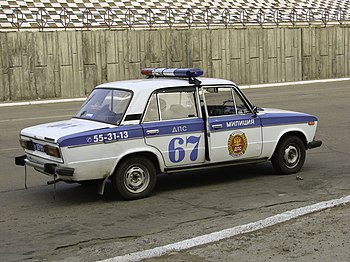 Alas, there is a whole Lada police corruption in Russia.
Alas, there is a whole Lada police corruption in Russia.
Historically very high, the crime rate has fallen dramatically since the breakup of the Soviet Union, and is moderate. Even though the crime issues are continuing to drop, assault, robbery, or pickpocketing are the most common crimes - more common in underground walkways, the subway, overnight trains, train stations, airports, markets, tourist attractions, and restaurants.
Foreigners who have been drinking alcohol are especially vulnerable to assault and robbery in or around nightclubs or bars, or on their way home. Spiking is a threat to travelers at bars, so you should keep an eye on your drink all the time and don't leave your drink behind when going to the toilet.
The use of unmarked taxis is also a problem, as passengers have been victims of robbery, kidnapping, extortion, and theft. Although there are few registered taxi services in Russia, you should always use authorized services when arriving at a major airport, and it is best to ask which is registered before moving along. Bogus trolley inspectors, whose aim is to extort a bribe from individuals while checking for trolley tickets, are also a threat, if an increasingly rare one in the 2020s.
Russia's law enforcement are generally well-trained and professional in their jobs. Although they were very inadequate after the Soviet Union's breakup, the government has fought police corruption fiercely with success. Policemen should not dare to take bribes anyone, as they themselves would end up being fined huge amounts. While there is an ongoing effort to shape up the police force initiated by the government, some policemen still remain underpaid, and therefore corrupt.
If you intend to take a stroll during the night, have someone to accompany you — going alone can only make you a target for corrupt policemen and criminals.
North CaucasusAs a tourist, you used to be strongly discouraged to travel to the North Caucasus, as the region suffers from terrorism, crime and extremes of both corruption and lawlessness.
After 2013, the situation has greatly improved and travel in the region is mostly safe, but check the safety of your planned itinerary and activities, and keep yourself updated. Many governments still recommend against travel at least to parts of the region.
LGBT travelersMale partners are strongly advised to avoid shows of affection and physical contact other than a handshake. Female partners can get away with non-sexual affection and physical contact, as it is considered acceptable. Cross-dressing is a strong no-no unless you know very well what you are doing.
Russia has seen a spike in homophobic activity, since the beginning of 2013 after a series of events that led to the adoption of a law establishing fines and deportation of foreigners for LGBT advocacy ("propaganda") directed towards minors. Although homosexuality is not illegal in Russia, you may have problems with the law if you participate in any LGBT advocacy activities where police would believe that minors could see you. This effectively includes all public "outdoors" advocacy events, including gay pride parades and festivals, and may also be extended to public demonstration of your orientation and gender identification where minors are present. Participating in indoors LGBT activities, and allowed outdoors actions, where necessary precautions against participating of minors have been taken is legal, but there is still a threat of being hunted by homophobic activists during such events, as they specifically target them. Besides the events, general wisdom about keeping your orientation and gender identification secret will keep you safe in most situations, but if it is exposed, you may face harassment or violence from people, including hosts, if they didn't know beforehand, service workers, and more unpleasantly, lack of cooperation from police, if you'll have to turn to them seeking help against hate crimes.
Driving City traffic in Russia (2016).
City traffic in Russia (2016).
Driving by the majority of Russians is routinely reckless (hence the viral dashcam videos), and claimed almost 26,000 lives in 2016. Reckless driving habits, the lack of proper training, and a mixture of very old to old model cars all what contributes to a high death rate on roads. Guidelines are lax and not always followed. As a pedestrian, take great care when crossing the roads, as pedestrian crossings are sometimes ignored. Most drivers are not very well trained and some have forged their licenses to avoid problems with the police. More importantly, the rapidly expanding economy has led to an increase in traffic density. Driving in the tunnels is perhaps even more dangerous than driving on the roads — the tunnels are improperly built as a result of underinvestment, and they claim even more casualties than on the roads.
When driving you must not be under the influence of alcohol. Russians have a zero tolerance to this, and the penalty is about two years imprisonment. If you are pulled over by the GIBDD (Russian Traffic Police), don't worry — they will simply check your papers. If they try to solicit a bribe, you are entitled to report it to the nearest police station. Under no circumstances try to run away from them — if you do, they will shoot your vehicle, even when you're not armed.
RacismRussia is a multicultural nation, due to historical conquests and immigration from parts of the former USSR and other parts of the world. Racially-motivated violent crimes, once a major issue, have dropped steadily since 2009, and the common traveller is unlikely to face any major problems.
People from Central Asia, and the North and South Caucasus are often viewed with distrust and contempt, and are often discriminated against by landlords. Similarly, individuals who aren't Russian and/or not from a Slavic-language speaking country can also be barred from renting homes in certain areas.
Interracial couples, particularly those in a relationship with a Russian local, may often attract unwanted stares and/or curiosity.
Identification papers Beautiful frescoes in a Vologda church
Beautiful frescoes in a Vologda church
Not carrying identification papers can lead to 3-hour detention "for identification purposes" (the law says "up to 48 hours" ). Formally, arbitrary document checks are not permitted, and the police officer that checks papers must introduce himself and explain the reason for checking. However, checks do happen, especially to people who might be suspected of being illegal immigrants. Document checks are more likely in places with little tourism – some police officers have very narrow notions of what should be appropriate for tourists.
Having no documents is no crime, and you cannot be arrested on that ground. Although rare, you can be taken to a police station, where you will end up sitting on a chair in a normal room while police "identify" you. You should not be deprived of your belongings (such as mobile phone).
You may choose to carry your passport, migration card and registration slip on you. If you do, keep a separate photocopy just in case. You may also choose to bring a photocopy of the passport (id and visa) and of the immigration card.
Being stopped for ID is not necessarily a pretext for a bribe. Normally a police officer will salute and ask for your passport (listen out for words like 'paspart', 'veeza' or 'dokumenty'). Hand these to them, they will look at them, hand them back and salute you. While generally an unnerving experience for first time tourists, there is nothing sinister in this.
A corrupt policeman may claim that there are problems with your documentation (passport, immigration card or residence registration), and demand a fine (bribe). You have three options: you may in a nice, friendly and firm manner explain that actually everything is fine, there is no problem with your documents and you are willing to go to the police station to clear things up; you can pay (300 руб should be enough in metropolitan areas); threaten. The first option is difficult without some Russian proficiency (and solid nerves), but will generally work. The second option buys you peace but encourages further corruption. The third option is more confrontational and requires some nerve: get out a mobile phone and threaten to call your embassy. This can work and the police may well back off.
ShoppingKeep your money folded with small notes on the outside, concealing the larger ones. Bring out your cash only when actually handing it over. Keep larger amounts separate and hidden from smaller day-to-day money.
Dangerous animalsMeeting packs of aggressive dogs that are strays or on guard duty but not chained or otherwise restrained is possible, especially off the beaten tourist path. Staying calm and holding your bags in front of you may prove sufficient. Follow other advice from the linked article if it's not.
There are bears and other potentially dangerous animals in the wilderness. If you intend to visit national parks or the like, check applicable safety measures.
If you get bitten, there is a risk for rabies; treat the wound and urgently seek professional care.


























